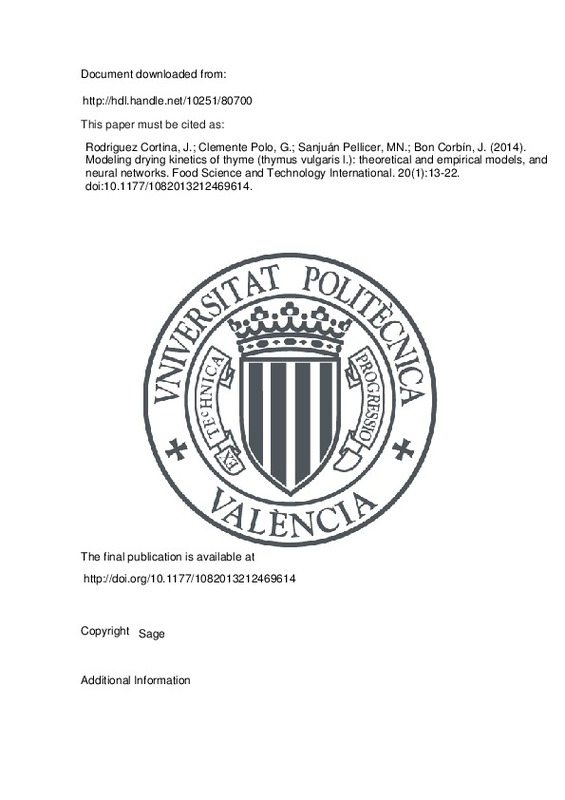JavaScript is disabled for your browser. Some features of this site may not work without it.
Buscar en RiuNet
Listar
Mi cuenta
Estadísticas
Ayuda RiuNet
Admin. UPV
Modeling drying kinetics of thyme (thymus vulgaris l.): theoretical and empirical models, and neural networks
Mostrar el registro sencillo del ítem
Ficheros en el ítem
| dc.contributor.author | Rodríguez Cortina, Jader
|
es_ES |
| dc.contributor.author | Clemente Polo, Gabriela
|
es_ES |
| dc.contributor.author | Sanjuán Pellicer, María Nieves
|
es_ES |
| dc.contributor.author | Bon Corbín, José
|
es_ES |
| dc.date.accessioned | 2017-05-08T06:42:37Z | |
| dc.date.available | 2017-05-08T06:42:37Z | |
| dc.date.issued | 2014-01 | |
| dc.identifier.issn | 1082-0132 | |
| dc.identifier.uri | http://hdl.handle.net/10251/80700 | |
| dc.description.abstract | [EN] The drying kinetics of thyme was analyzed by considering different conditions: air temperature of between 40 C and 70 C, and air velocity of 1 m/s. A theoretical diffusion model and eight different empirical models were fitted to the experimental data. From the theoretical model application, the effective diffusivity per unit area of the thyme was estimated (between 3.68 10 5 and 2.12 10 4 s 1). The temperature dependence of the effective diffusivity was described by the Arrhenius relationship with activation energy of 49.42 kJ/mol. Eight different empirical models were fitted to the experimental data. Additionally, the dependence of the parameters of each model on the drying temperature was determined, obtaining equations that allow estimating the evolution of the moisture content at any temperature in the established range. Furthermore, artificial neural networks were developed and compared with the theoretical and empirical models using the percentage of the relative errors and the explained variance. The artificial neural networks were found to be more accurate predictors of moisture evolution with VAR 99.3% and ER 8.7%. | es_ES |
| dc.description.sponsorship | The authors acknowledge the financial support from the 'Ministerio de Educacion y Ciencia' in Spain, CONSOLIDER INGENIO 2010 (CSD2007-00016). | en_EN |
| dc.language | Inglés | es_ES |
| dc.publisher | Sage | es_ES |
| dc.relation.ispartof | Food Science and Technology International | es_ES |
| dc.rights | Reserva de todos los derechos | es_ES |
| dc.subject | Drying | es_ES |
| dc.subject | Kinetics | es_ES |
| dc.subject | Thyme | es_ES |
| dc.subject | Neural networks | es_ES |
| dc.subject.classification | TECNOLOGIA DE ALIMENTOS | es_ES |
| dc.title | Modeling drying kinetics of thyme (thymus vulgaris l.): theoretical and empirical models, and neural networks | es_ES |
| dc.type | Artículo | es_ES |
| dc.identifier.doi | 10.1177/1082013212469614 | |
| dc.relation.projectID | info:eu-repo/grantAgreement/MEC//CSD2007-00016/ES/PRODUCTOS CARNICOS PARA EL SIGLO XXI: SEGUROS, NUTRITIVOS Y SALUDABLES/ | es_ES |
| dc.rights.accessRights | Abierto | es_ES |
| dc.contributor.affiliation | Universitat Politècnica de València. Departamento de Tecnología de Alimentos - Departament de Tecnologia d'Aliments | es_ES |
| dc.contributor.affiliation | Universitat Politècnica de València. Escuela Técnica Superior de Ingeniería Agronómica y del Medio Natural - Escola Tècnica Superior d'Enginyeria Agronòmica i del Medi Natural | es_ES |
| dc.description.bibliographicCitation | Rodríguez Cortina, J.; Clemente Polo, G.; Sanjuán Pellicer, MN.; Bon Corbín, J. (2014). Modeling drying kinetics of thyme (thymus vulgaris l.): theoretical and empirical models, and neural networks. Food Science and Technology International. 20(1):13-22. https://doi.org/10.1177/1082013212469614 | es_ES |
| dc.description.accrualMethod | S | es_ES |
| dc.relation.publisherversion | http://doi.org/10.1177/1082013212469614 | es_ES |
| dc.description.upvformatpinicio | 13 | es_ES |
| dc.description.upvformatpfin | 22 | es_ES |
| dc.type.version | info:eu-repo/semantics/publishedVersion | es_ES |
| dc.description.volume | 20 | es_ES |
| dc.description.issue | 1 | es_ES |
| dc.relation.senia | 256929 | es_ES |
| dc.identifier.eissn | 1532-1738 | |
| dc.identifier.pmid | 23733820 | |
| dc.contributor.funder | Ministerio de Educación y Ciencia | es_ES |







![[Cerrado]](/themes/UPV/images/candado.png)

